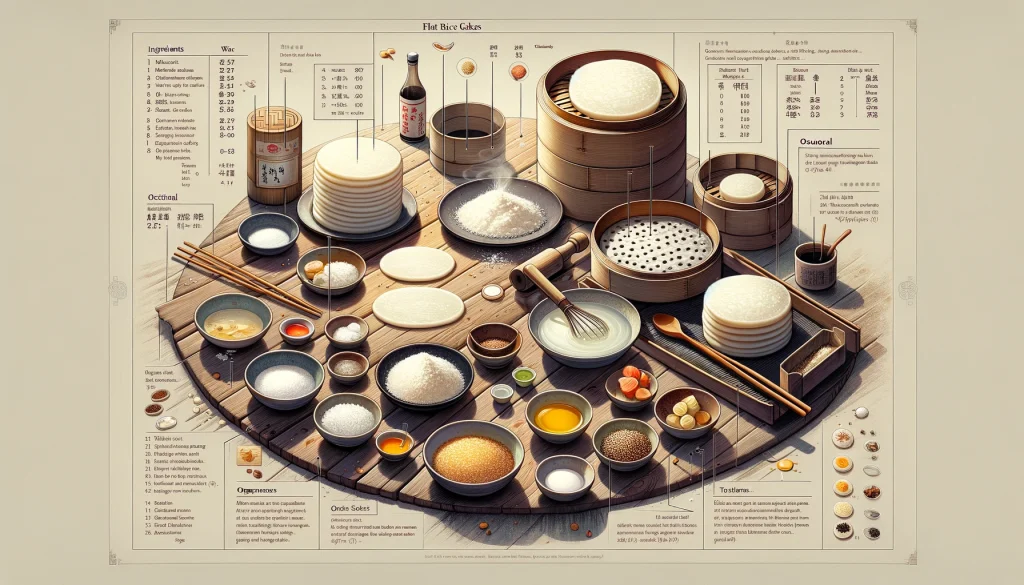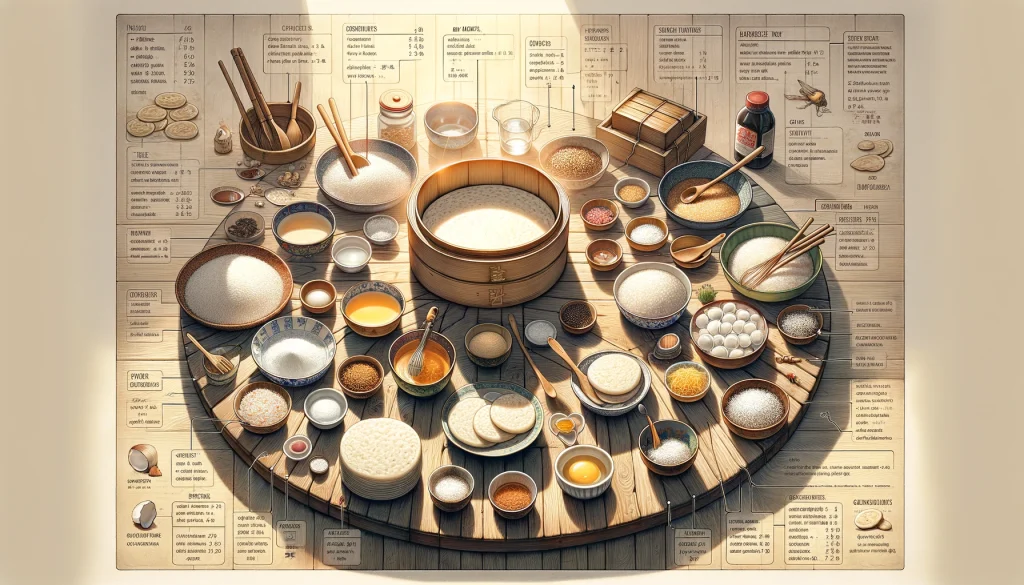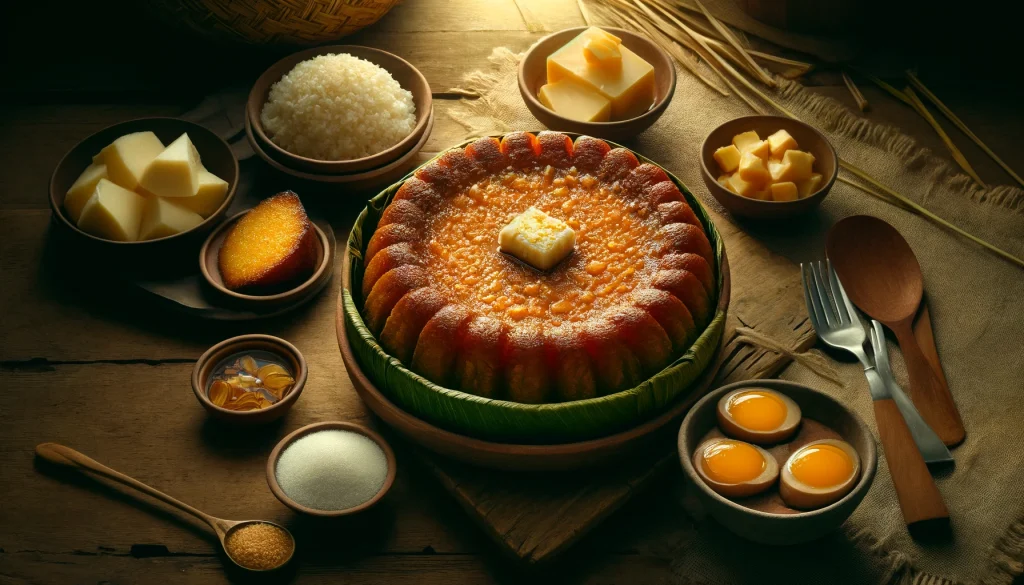As an Amazon Associate I earn from qualifying purchases.
Step into the vibrant world of Filipino cuisine with our enticing introduction to Bibingka, a beloved sweet rice cake that holds a cherished place in Filipino culinary heritage. A delightful fusion of glutinous rice flour, coconut milk, and sugar, Bibingka tantalizes the taste buds with its rich flavors and comforting texture. As you embark on this culinary journey, prepare to discover the warmth and nostalgia that Bibingka brings to Filipino homes, evoking memories of festive celebrations and joyful gatherings. Join us as we delve deeper into the art of crafting this beloved dessert, inviting you to savor the sweetness of Filipino tradition with every delectable bite.
Filipino Sweet Rice Cake Recipe

Dive into the delightful world of Filipino desserts with our recipe for Bibingka, a traditional sweet rice cake that embodies the essence of Filipino cuisine. Made with glutinous rice flour, coconut milk, and sugar, Bibingka is a beloved treat often enjoyed during special occasions and festive gatherings. Its soft, chewy texture and subtle coconut flavor make it a comforting indulgence that captures the warmth and hospitality of Filipino hospitality.
Ingredients:
- 2 cups glutinous rice flour
- 1 cup coconut milk
- 1/2 cup sugar
- 1/4 cup butter, melted
- 2 eggs
- 1 teaspoon baking powder
- 1/4 teaspoon salt
- Banana leaves (for lining the baking pan)
- Grated coconut (for topping, optional)
Instructions:
- Preheat your oven to 350°F (175°C). Grease a 9×9 inch baking pan and line it with banana leaves, ensuring that they cover the bottom and sides of the pan.
- In a mixing bowl, combine the glutinous rice flour, sugar, baking powder, and salt. Mix well to ensure that the dry ingredients are evenly distributed.
- In a separate bowl, whisk together the coconut milk, melted butter, and eggs until well combined.
- Gradually add the wet ingredients to the dry ingredients, stirring until a smooth batter forms. Be careful not to overmix.
- Pour the batter into the prepared baking pan, spreading it evenly with a spatula.
- Bake in the preheated oven for 25-30 minutes, or until the edges are golden brown and a toothpick inserted into the center comes out clean.
- Once baked, remove the Bibingka from the oven and allow it to cool slightly before slicing and serving.
- For an extra touch of sweetness, sprinkle grated coconut over the top of the Bibingka before serving.
Enjoying Your Bibingka:
- Slice the Bibingka into squares and serve warm or at room temperature. Pair it with a cup of hot tea or coffee for a delightful snack or dessert. Whether enjoyed on its own or shared with loved ones, Bibingka is sure to bring a taste of Filipino sweetness to any occasion.
Expert Tips for Perfecting Your Filipino Sweet Rice Cake (Bibingka)
- Quality Ingredients: Use fresh and high-quality ingredients for the best results. Opt for coconut milk that is rich and creamy, and choose glutinous rice flour that is finely ground and free from any lumps.
- Banana Leaves: Banana leaves not only add flavor but also help keep the Bibingka moist and impart a subtle aroma during baking. Ensure the leaves are clean and pliable before using them to line the baking pan. If banana leaves are not available, you can use parchment paper as a substitute.
- Proper Mixing: When combining the wet and dry ingredients, mix them until just combined. Overmixing can result in a tough texture. Stir the batter gently until there are no large lumps, but small lumps are fine as they will dissolve during baking.
- Baking Time and Temperature: Keep a close eye on the Bibingka while baking to prevent it from overcooking and becoming dry. Oven temperatures vary, so start checking for doneness around the 25-minute mark. The edges should be golden brown, and a toothpick inserted into the center should come out clean.
- Enhancing Flavor: Experiment with flavor variations by adding ingredients such as grated cheese, coconut flakes, or even salted egg slices on top of the Bibingka before baking. These additions can elevate the taste and texture of the rice cake, adding depth and complexity to the final dish.
- Storage: Bibingka is best enjoyed fresh but can be stored in an airtight container at room temperature for up to 2 days. Reheat individual slices in the microwave for a few seconds before serving to restore their softness and warmth.
- Serving Suggestions: Bibingka pairs wonderfully with a hot cup of coffee or tsokolate (Filipino hot chocolate). For a festive touch, serve it with grated coconut on the side or drizzle it with condensed milk for added sweetness.
- Sharing the Experience: Filipino cuisine is all about sharing and celebrating with loved ones. Invite friends and family to enjoy the Bibingka together, sharing stories and creating cherished memories over this delicious Filipino delicacy.
By incorporating these expert tips into your Bibingka-making process, you can ensure that your Filipino sweet rice cake turns out perfectly every time. Enjoy the rich flavors, comforting textures, and warm hospitality that Bibingka brings to your table.
Why This Recipe Is Just So Good…

This Filipino sweet rice cake recipe, known as Bibingka, embodies the essence of Filipino culinary heritage and is beloved for several reasons:
- Rich Flavor Profile: The combination of coconut milk, glutinous rice flour, sugar, and butter creates a harmonious blend of sweet and creamy flavors that are characteristic of Filipino desserts. Each bite is filled with a comforting richness that is sure to satisfy your sweet tooth.
- Soft and Chewy Texture: The use of glutinous rice flour gives Bibingka its signature soft and chewy texture, making it a delightful treat to enjoy. It offers a pleasing contrast to the slightly crispy edges, creating a perfect balance of textures in every bite.
- Cultural Significance: Bibingka is deeply rooted in Filipino culture and is often associated with festive occasions such as Christmas, Easter, and other special celebrations. It holds sentimental value for many Filipinos, evoking memories of family gatherings and cherished traditions.
- Versatility: While Bibingka is delicious on its own, it also serves as a versatile canvas for creative flavor variations. You can customize it by adding toppings such as grated cheese, coconut flakes, or salted egg slices, allowing you to tailor the recipe to your personal preferences.
- Comforting and Nostalgic: For those familiar with Filipino cuisine, Bibingka offers a sense of comfort and nostalgia that transports them back to their roots. It’s a taste of home that brings warmth and joy with every bite, making it a favorite among Filipinos both at home and abroad.
- Easy to Make: Despite its rich and indulgent flavor, Bibingka is relatively simple to make, requiring just a few basic ingredients and minimal preparation time. This accessibility allows anyone to recreate the comforting flavors of Filipino desserts in their own kitchen.
- Sharing and Celebration: Bibingka is often enjoyed in the company of loved ones, making it a symbol of togetherness and celebration. Whether served at family gatherings, potlucks, or special events, Bibingka brings people together to share in the joy of good food and cherished traditions.
Overall, the Filipino sweet rice cake recipe for Bibingka is simply irresistible due to its delicious flavor, comforting texture, cultural significance, and the joy it brings to those who enjoy it. It’s a timeless classic that continues to captivate hearts and taste buds around the world.
Storage Instructions
Proper storage of your Filipino sweet rice cake (Bibingka) is key to maintaining its freshness and flavor. Here are some guidelines to ensure your Bibingka remains delicious even after it has cooled down:
Short-Term Storage
- Cool Down Completely: Before storing, allow the Bibingka to cool down completely at room temperature. This prevents condensation inside the container, which could make the rice cake soggy.
- Refrigerate: If you plan to eat the Bibingka within a few days, wrap it tightly in plastic wrap or aluminum foil to prevent it from absorbing odors from the refrigerator. Alternatively, you can store it in an airtight container. Bibingka can be kept in the refrigerator for up to 3-5 days.
- Serve Warm: When ready to enjoy again, you might want to warm the Bibingka slightly in the microwave for a few seconds or in a preheated oven at 350°F (175°C) for about 5-10 minutes to help restore its soft texture and warmth.
Long-Term Storage
- Freezing: For longer storage, Bibingka can be frozen. Wrap individual slices or the entire cake securely in plastic wrap, then again in aluminum foil, or place it in a freezer-safe bag or airtight container. This method helps prevent freezer burn and keeps the Bibingka fresh for up to 2 months.
- Thawing and Reheating: When you’re ready to enjoy your frozen Bibingka, thaw it overnight in the refrigerator. Reheat it in the microwave for a short time or in the oven at 350°F (175°C) until it’s warmed through. If it seems a bit dry, you can cover it with a damp paper towel while reheating in the microwave to help reintroduce some moisture.
Additional Tips
- Avoid Direct Sunlight: Always store the Bibingka in a cool, dry place away from direct sunlight to prevent spoilage.
- Labeling: If freezing, label the container or wrapping with the date, so you can keep track of how long the Bibingka has been stored.
Following these storage instructions will help ensure that your Filipino sweet rice cake remains as delightful as the day it was made, ready to be enjoyed again with its best texture and flavor intact.
Frequently Asked Questions (FAQ)

Q: What is Bibingka?
A: Bibingka is a traditional Filipino sweet rice cake made from glutinous rice flour, coconut milk, sugar, and eggs. It is a popular dessert often enjoyed during special occasions and festive celebrations in the Philippines.
Q: How do I make Bibingka without banana leaves?
A: While traditionally, Bibingka is baked in banana leaves, you can still make it without them. Simply grease your baking pan well to prevent sticking, or line it with parchment paper as a substitute.
Q: Can I use regular rice flour instead of glutinous rice flour?
A: Glutinous rice flour is essential for achieving the characteristic chewy texture of Bibingka. Using regular rice flour will result in a different texture, so it’s best to stick to glutinous rice flour for an authentic Bibingka experience.
Q: Can I use canned coconut milk instead of fresh coconut milk?
A: Yes, you can use canned coconut milk as a convenient alternative to fresh coconut milk. Just make sure to shake the can well before using it to ensure the coconut milk is well mixed.
Q: How do I know when Bibingka is done baking?
A: Bibingka is typically done baking when the edges are golden brown and a toothpick inserted into the center comes out clean. The cake should be firm to the touch and slightly springy.
Q: Can I freeze Bibingka?
A: Yes, Bibingka can be frozen for later enjoyment. Wrap individual slices or the entire cake tightly in plastic wrap, then place it in a freezer-safe container or bag. Thaw overnight in the refrigerator before reheating and serving.
Q: What are some common toppings for Bibingka?
A: Common toppings for Bibingka include grated cheese, grated coconut, salted egg slices, and butter. These toppings add richness and flavor to the sweet rice cake.
Q: How long does Bibingka stay fresh?
A: Bibingka is best enjoyed fresh on the day it is baked. However, it can be stored in an airtight container at room temperature for up to 2-3 days. Reheat individual slices in the microwave or oven before serving to restore their softness and warmth.
Q: Can I make Bibingka ahead of time?
A: Yes, you can make Bibingka ahead of time and store it in an airtight container at room temperature or in the refrigerator. Reheat slices before serving for the best taste and texture.
Q: Can I add other flavors to Bibingka?
A: Yes, you can experiment with adding other flavors to Bibingka, such as pandan extract, ube (purple yam) flavoring, or even cocoa powder for a chocolate twist. Just adjust the amount of flavoring to suit your taste preferences.
Q: What makes Bibingka a popular dessert in Filipino cuisine?
A: Bibingka’s popularity in Filipino cuisine can be attributed to its delicious flavor, soft and chewy texture, and its cultural significance. It’s often enjoyed during special occasions and festivities, evoking feelings of warmth and nostalgia.
Q: Can Bibingka be made with alternative ingredients for dietary restrictions?
A: Yes, Bibingka can be adapted to accommodate various dietary restrictions. For example, you can use gluten-free glutinous rice flour for a gluten-free version, or coconut sugar for a lower glycemic index option. You can also experiment with dairy-free alternatives for coconut milk and butter for a vegan-friendly version.
Q: What are some common variations or toppings for Bibingka?
A: Traditional toppings for Bibingka include grated cheese, grated coconut, salted egg slices, and sometimes even butter or margarine. Some modern variations may include toppings such as ube (purple yam) jam, macapuno (coconut sport), or even chocolate drizzle for a decadent twist.
Q: How does Bibingka differ from other Filipino rice cakes like Puto or Kutsinta?
A: While all are Filipino rice cakes, Bibingka is distinct in its use of glutinous rice flour, coconut milk, and baking powder, which give it a soft and slightly chewy texture. Puto is steamed and has a lighter, sponge-like texture, while Kutsinta is chewy and jelly-like, often flavored with lye water and annatto extract.
Q: Are there any regional variations of Bibingka in the Philippines?
A: Yes, Bibingka may vary in ingredients and preparation methods across different regions of the Philippines. For example, in some regions, Bibingka may include toppings like kesong puti (white cheese) or even slices of salted duck egg. Additionally, there are regional specialties like Bibingka Malagkit, made with glutinous rice and coconut milk.
Q: What’s the best way to serve Bibingka for a traditional Filipino dessert spread?
A: Bibingka is traditionally served warm, often accompanied by a cup of hot chocolate or coffee. It’s best enjoyed fresh out of the oven, but you can also reheat slices slightly before serving. For a festive touch, present Bibingka on a banana leaf-lined platter and sprinkle toppings generously over the cake slices.
Q: How can I add my own twist to the Bibingka recipe while still maintaining its traditional flavors?
A: You can experiment with adding flavor variations to the Bibingka batter, such as incorporating pandan extract or ube flavoring for a unique twist. Additionally, try experimenting with different toppings or fillings to create your own signature Bibingka recipe while still honoring its traditional roots.
Conclusion
As our culinary journey comes to a close, we hope you’ve been inspired to embrace the heartwarming allure of Bibingka, a staple of Filipino dessert cuisine. This sweet rice cake, with its soft, chewy texture and rich, coconut-infused flavor, is more than just a treat; it’s a vibrant celebration of Filipino culture and traditions. Whether shared with loved ones during festive seasons or enjoyed as a comforting snack, Bibingka has the unique ability to bring people together, making every bite a shared experience of joy and nostalgia.
We encourage you to explore the simplicity and beauty of making Bibingka at home, experimenting with toppings and flavors to make it uniquely yours. Remember, every variation of this beloved recipe carries the essence of Filipino warmth and hospitality. So, as you savor your homemade Bibingka, let it remind you of the rich culinary traditions that shape our world’s diverse cultures. Here’s to discovering the sweetness of Filipino heritage, one slice of Bibingka at a time.






